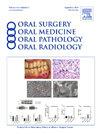Suboptimal patient positioning with panoramic and cone beam computed tomography (CBCT) imaging: effects on dose
IF 2
3区 医学
Q2 DENTISTRY, ORAL SURGERY & MEDICINE
Oral Surgery Oral Medicine Oral Pathology Oral Radiology
Pub Date : 2025-02-04
DOI:10.1016/j.oooo.2024.11.017
引用次数: 0
Abstract
Objective
The aim of this study is to examine the effects of various changes in patient positioning on radiation exposure for panoramic and cone beam computed tomography (CBCT) extraoral radiographic examinations. Specific objectives include measuring equivalent and effective dose by means of radiation dosimetry with a tissue-equivalent phantom for each modality, with intentional changes in position to the craniofacial complex.
Study Design
Simulated panoramic and CBCT radiographic examinations at optimal positioning in addition to 6 suboptimal positions—anterior, posterior, and lateral shifts by 1 cm; and neck extension (i.e., chin tilted up), flexion (i.e., chin tiled down), and rotation by 10 degrees—were completed using an adult tissue-equivalent phantom. Dosimetry was acquired using optically stimulated luminescence dosimeters placed at 24 anatomical sites in the head/neck region. Exposures were made with the RayScan Alpha Plus x-ray unit using the following exposure parameters for panoramic imaging: 13.9 seconds, 80 kVp, 14 mA; and for CBCT: 14.0 seconds, 90 kVp, 11 mA. Five CBCT and 10 panoramic exposures, respectively, were made to ensure adequate exposure to all sites of interest.
Results
No increases in E were determined for suboptimal panoramic conditions. E for anterior shift (26.9 μSv) and posterior shift (28.1 μSv) demonstrated statistically-significant decreases (P < .001) when compared with optimal positioning (50.0 μSv). For CBCT, no statistically significant changes for E were determined, although equivalent thyroid dose was significantly increased (P = .003) when the chin was titled down (1882.7 μSv) in comparison with optimal positioning (1674.4 μSv).
Conclusions
No suboptimal positions resulted in significant increases in E for either CBCT or panoramic imaging. Initial results suggest that tilting the chin down may increase exposure to the thyroid gland for CBCT imaging. Additional exposures at smaller fields of view are warranted, in addition to exposures with a stabilized thyroid gland position.
求助全文
约1分钟内获得全文
求助全文
来源期刊

Oral Surgery Oral Medicine Oral Pathology Oral Radiology
DENTISTRY, ORAL SURGERY & MEDICINE-
CiteScore
3.80
自引率
6.90%
发文量
1217
审稿时长
2-4 weeks
期刊介绍:
Oral Surgery, Oral Medicine, Oral Pathology and Oral Radiology is required reading for anyone in the fields of oral surgery, oral medicine, oral pathology, oral radiology or advanced general practice dentistry. It is the only major dental journal that provides a practical and complete overview of the medical and surgical techniques of dental practice in four areas. Topics covered include such current issues as dental implants, treatment of HIV-infected patients, and evaluation and treatment of TMJ disorders. The official publication for nine societies, the Journal is recommended for initial purchase in the Brandon Hill study, Selected List of Books and Journals for the Small Medical Library.
 求助内容:
求助内容: 应助结果提醒方式:
应助结果提醒方式:


